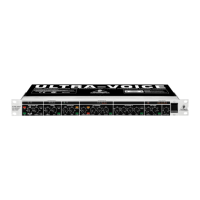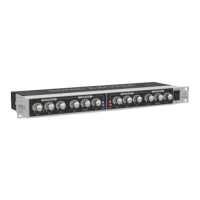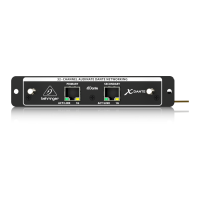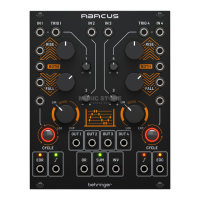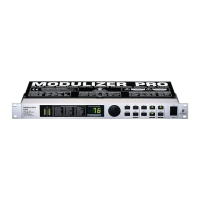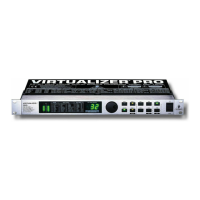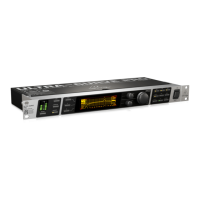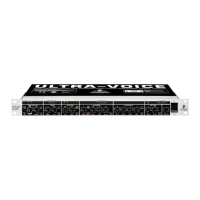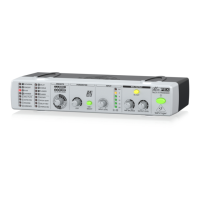27
E
4.4 SuperBass
Apart from processing the upper harmonic ranges, users of the BEHRINGER ULTRAMIZERPRO have access
to an innovative Bass Processor.
The numerous stages of processing during the recording, reproduction, copying and effecting processes,
increasingly delay the phase of the bass frequencies, when compared to the remaining frequency ranges.
This is why the low-frequency range suffers from a loss in power and fundamental bass definition.
With the help of frequency-selective phase shift combined with sub-bass boost, the bass processor of the
BEHRINGER ULTRAMIZERPRO is capable of compensating for this loss, giving the program material new
bass presence.
4.5 3DSurround Processor
Sound quality during signal transmission is given top priority today. The signal is processed with the help of
Reverb Devices, Compressors, Exciters, Denoisers etc. to produce a compact, low-noise and transparent
sound.
However, the fact that hearing impression depends largely upon the positioning of the instruments within the
stereo panorama is often enough neglected. Using the 3DSurround processor of the ULTRAMIZERPRO, the
intensity of the stereo effect can be dramatically improved. The program material gains in liveliness, loudness
and transparency. As in a cinema with its special acoustics, the listener has the impression that the orches-
tral instruments are placed all around him. The 3DSurround processor enlarges the stereo basis dependent
on the program material, without audibly coloring the sonic image.
The function of the 3DSurround Processor is based on the derivation of a special signal, which is generated
from the difference of the left an right channel. This signal is then delayed program dependently and mixed
with the original signal. The difference between the two channels is the stereo substance whose ambient
and spatial information is improved by delaying the signal.
+ Due to the described function, the 3DSurround Processor is principally useful only with stereo
program material.
4.6 Digital audio processing
In order to convert an analog signal - e.g. music - into a series of digital words, a so-called Analog to Digital
Converter or ADC is used. The converter functions by viewing the signal entering it a given number of times
over a period of time, e.g. 44,100 times per second, giving a rate of 44.1kHz, and in each case measuring
the signal amplitude, and giving it a numerical value. This form of measuring the signal regularly over a period
of time is known as sampling, the conversion of the amplitude into a numerical value, quantizing. The two
actions together are referred to as digitizing.
In order to carry out the opposite - the conversion of a digitized signal into its original analog form - a Digital
to Analog Converter or DAC is used. In both cases the frequency at which the device operates is called the
sampling rate. The sampling rate determines the effective audio frequency range. The sampling rate must
always be more than twice the value of the highest frequency to be reproduced. Therefore, the well known CD
sampling rate of 44.1kHz is slightly higher than twice the highest audible frequency of 20kHz. The accuracy
at which quantization takes place is primarily dependent on the quality of the ADCs and DACs being used.
The resolution, or size of digital word used (expressed in bits), determines the theoretical signal/noise ratio
(S/N ratio) the audio system is capable of providing. The number of bits may be compared to the number of
decimal places used in a calculation - the greater the number of places, the more accurate the end result.
Theoretically, each extra bit of resolution should result in the S/N ratio increasing by 6dB. Unfortunately,
there are a considerable number of other factors to be taken into account, which hinder the achievement of
these theoretical values.
4. TECHNICAL BACKGROUND
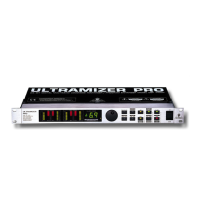
